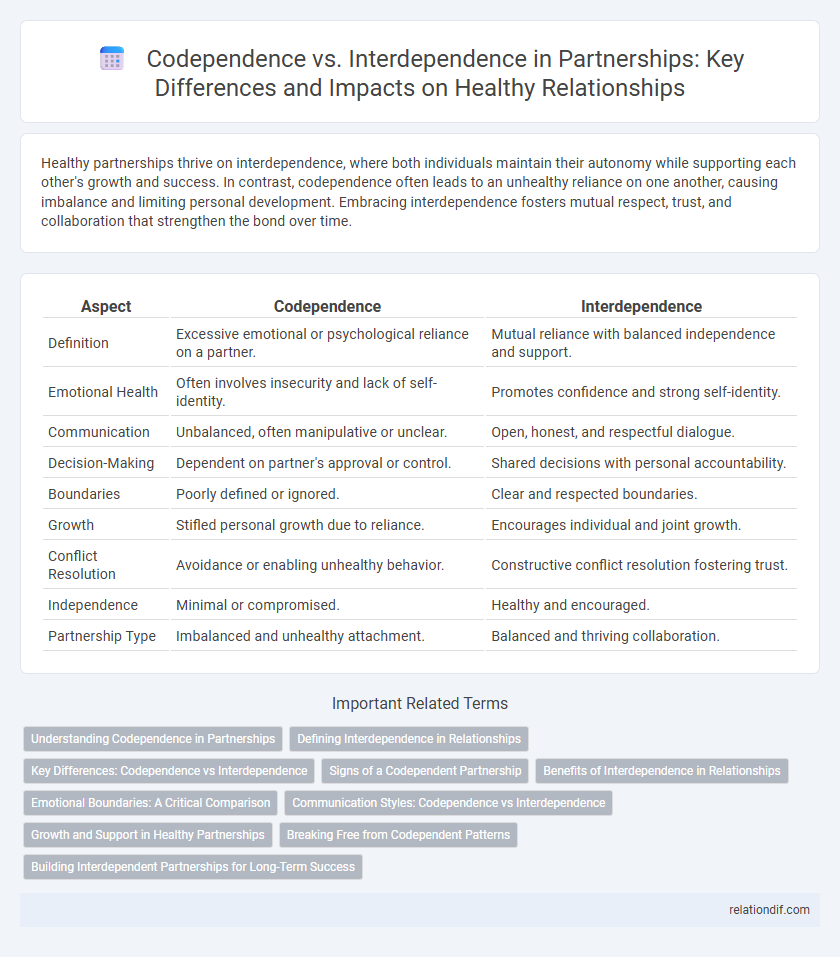Healthy partnerships thrive on interdependence, where both individuals maintain their autonomy while supporting each other's growth and success. In contrast, codependence often leads to an unhealthy reliance on one another, causing imbalance and limiting personal development. Embracing interdependence fosters mutual respect, trust, and collaboration that strengthen the bond over time.
Table of Comparison
| Aspect | Codependence | Interdependence |
|---|---|---|
| Definition | Excessive emotional or psychological reliance on a partner. | Mutual reliance with balanced independence and support. |
| Emotional Health | Often involves insecurity and lack of self-identity. | Promotes confidence and strong self-identity. |
| Communication | Unbalanced, often manipulative or unclear. | Open, honest, and respectful dialogue. |
| Decision-Making | Dependent on partner's approval or control. | Shared decisions with personal accountability. |
| Boundaries | Poorly defined or ignored. | Clear and respected boundaries. |
| Growth | Stifled personal growth due to reliance. | Encourages individual and joint growth. |
| Conflict Resolution | Avoidance or enabling unhealthy behavior. | Constructive conflict resolution fostering trust. |
| Independence | Minimal or compromised. | Healthy and encouraged. |
| Partnership Type | Imbalanced and unhealthy attachment. | Balanced and thriving collaboration. |
Understanding Codependence in Partnerships
Codependence in partnerships often manifests as an excessive emotional or psychological reliance on a partner, leading to blurred personal boundaries and unmet individual needs. This dynamic can foster imbalance, where one partner consistently prioritizes the other's desires over their own well-being, inhibiting healthy growth and mutual respect. Recognizing codependent patterns is essential to transition toward interdependence, promoting autonomy alongside connectedness within the relationship.
Defining Interdependence in Relationships
Interdependence in relationships is characterized by mutual reliance where both partners maintain their individuality while supporting each other's growth and well-being. Unlike codependence, which often involves excessive emotional or psychological reliance, interdependence fosters balanced autonomy and collaboration, enhancing trust and communication. This dynamic enables couples to navigate challenges effectively, creating a resilient and healthy partnership.
Key Differences: Codependence vs Interdependence
Codependence involves one partner excessively relying on the other for emotional support and validation, often leading to imbalance and loss of individual autonomy. Interdependence fosters mutual support while maintaining individual independence, enabling both partners to grow and thrive together. Key differences include autonomy, emotional health, and the ability to maintain boundaries within the partnership.
Signs of a Codependent Partnership
Signs of a codependent partnership include excessive reliance on a partner for approval and self-worth, neglecting personal needs to maintain the relationship, and difficulty setting healthy boundaries. Frequent feelings of guilt or responsibility for the partner's emotions often indicate an imbalance. This dynamic undermines mutual growth, contrasting with healthy interdependence characterized by respect, communication, and individual autonomy within the partnership.
Benefits of Interdependence in Relationships
Interdependence in relationships fosters mutual growth by allowing partners to support each other's goals while maintaining individual autonomy. This balance enhances emotional resilience, trust, and communication, reducing the likelihood of unhealthy codependence. Couples who practice interdependence experience deeper connection and increased satisfaction through shared responsibilities and collective problem-solving.
Emotional Boundaries: A Critical Comparison
Emotional boundaries in codependence often blur, leading to excessive reliance on a partner's validation and feelings, which can hinder personal growth and self-awareness. In interdependence, clear emotional boundaries preserve individual autonomy while allowing mutual support, fostering healthy communication and balanced emotional exchange. Recognizing and maintaining these boundaries is crucial to developing a resilient partnership based on respect and emotional well-being.
Communication Styles: Codependence vs Interdependence
In codependent partnerships, communication often involves seeking approval and avoiding conflict, leading to unclear boundaries and emotional enmeshment. Interdependent relationships emphasize open, honest dialogue where both partners express needs and listen actively, fostering mutual respect and autonomy. Effective communication in interdependence strengthens trust and supports balanced support systems without sacrificing individual identities.
Growth and Support in Healthy Partnerships
Growth in healthy partnerships flourishes through interdependence, where both individuals actively support each other's development while maintaining their autonomy. Unlike codependence, which fosters reliance and limits personal progress, interdependence encourages mutual encouragement and balanced contribution. This dynamic creates a resilient foundation for continuous growth and emotional support in the relationship.
Breaking Free from Codependent Patterns
Breaking free from codependent patterns requires recognizing emotional boundaries and fostering self-awareness to cultivate healthier interactions. Interdependence promotes mutual support while maintaining individual autonomy, balancing connection with personal growth. Developing communication skills and setting clear limits are essential steps to transform codependency into empowering, balanced partnerships.
Building Interdependent Partnerships for Long-Term Success
Building interdependent partnerships fosters a balance where both parties maintain autonomy while relying on each other's strengths for shared goals. This dynamic encourages collaboration, trust, and mutual growth, avoiding the pitfalls of unhealthy codependence. Effective interdependence leads to sustainable success by leveraging complementary skills and resources in a way that supports long-term partnership resilience.
codependence vs interdependence Infographic

 relationdif.com
relationdif.com